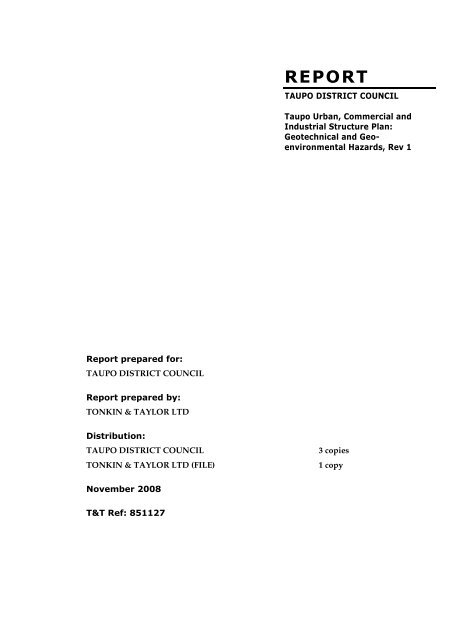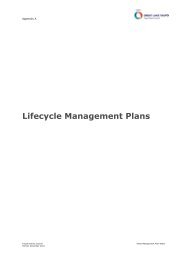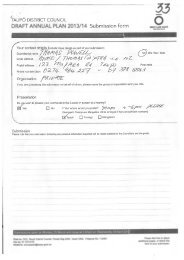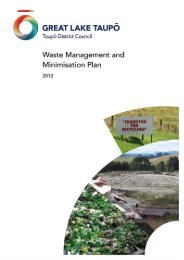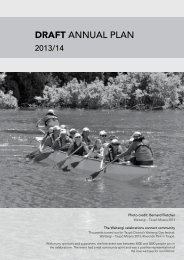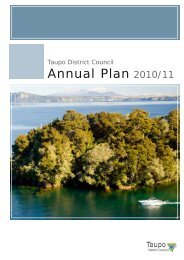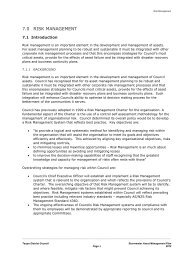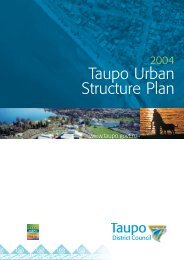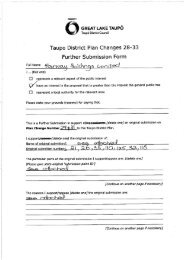Geotechnical Assessment - Taupo District Council
Geotechnical Assessment - Taupo District Council
Geotechnical Assessment - Taupo District Council
You also want an ePaper? Increase the reach of your titles
YUMPU automatically turns print PDFs into web optimized ePapers that Google loves.
TAUPO DISTRICT COUNCIL<br />
<br />
TONKIN & TAYLOR LTD<br />
<br />
TAUPO DISTRICT COUNCIL<br />
TONKIN & TAYLOR LTD (FILE)<br />
3 copies<br />
1 copy
1 Introduction 1<br />
2 Site Description 1<br />
3 Methodology 2<br />
3.1 <strong>Geotechnical</strong> methodology 2<br />
3.2 Geo-environmental methodology 2<br />
4 <strong>Geotechnical</strong> Hazards 3<br />
4.1 Faulting 3<br />
4.2 Flood Hazard Zones 3<br />
4.3 Hot Ground Hazard Areas 4<br />
4.4 Land Instability 4<br />
4.4.1 Tomos/Piping<br />
4<br />
4.4.2 Landsliding<br />
5<br />
4.5 Subsidence 5<br />
4.5.1 Regional Subsidence<br />
5<br />
4.5.2 Local Subsidence/Settlement<br />
6<br />
4.6 Erosion Hazard Areas 6<br />
5 Geo-environmental Hazards 6<br />
5.1 <strong>Taupo</strong> <strong>District</strong> <strong>Council</strong> and Environment Waikato Database 7<br />
5.2 Historical Aerial Photographs 7<br />
5.3 Personal Discussions 8<br />
5.4 Site Walkover Inspection 8<br />
6 Conclusions 8<br />
7 Applicability & Limitation 10<br />
Appendix A:<br />
Appendix B:<br />
Figures<br />
Potential Hazards by Area
<strong>Taupo</strong> <strong>District</strong> <strong>Council</strong> (TDC) is looking to establish more land for commercial and<br />
industrial activities. A number of parcels of rural land totalling approximately 500<br />
hectares have been identified in <strong>Taupo</strong> <strong>District</strong> 2050 (TD2050) as potentially commercial<br />
or industrial. A structure plan is therefore required to determine the suitability of this<br />
land to support such activities. It is envisaged that preparation of the structure plan will<br />
be the first step towards re-zoning the land from its current ‘Rural’ status to a zoning that<br />
would allow commercial/industrial use. To effect this change TDC requires information<br />
regarding a number of different aspects of the proposed industrial areas.<br />
TDC has engaged Tonkin & Taylor Ltd to carry out a geotechnical and geo-environmental<br />
assessment of the proposed industrial areas. In particular we have been asked to<br />
investigate the following:<br />
• Fault lines;<br />
• Flood hazard areas;<br />
• Hot ground hazard areas;<br />
• Known contaminated or potentially contaminated sites;<br />
• Areas of land instability (landsliding and tomos);<br />
• Erosion hazard areas; and<br />
• Areas of regional subsidence.<br />
<br />
<br />
The proposed industrial sites are located to the east, west and south of <strong>Taupo</strong> Township.<br />
For the purposes of this study the proposed industrial sites have been broken down into<br />
ten areas. These areas are shown in Figure 1.<br />
The geology underlying the general <strong>Taupo</strong> Area comprises various ignimbrites, volcanic<br />
airfall deposits and lake sediments. The main geological units that are likely to underlie<br />
the proposed industrial areas are:<br />
• Lacustrine and fluvial deposits of the Huka Formation (300 to 26.5 ka);<br />
• Primary Oruanui Ignimbrite (26.5 ka);<br />
• Reworked Oruanui Ignimbrite;<br />
• A lava dome buried beneath younger deposits in Area 4;<br />
• Many airfall and flow deposits, including the Wamihia Ignimbrite, with many<br />
paleosols (old, buried, organic soil horizons), thin reworked pumice deposits and<br />
loess (26.5 to 1.8 ka);<br />
• <strong>Taupo</strong> Ignimbrite and associated airfall deposits (1.8 ka);<br />
• Fluvial sediments reworked from the 1.8 ka <strong>Taupo</strong> deposits.<br />
A detailed description of each of these units is beyond the scope of this report, but:<br />
• Huka Group sediments generally comprise well bedded lacustrine siltstone and<br />
diatomite as well as fluvial sandstone, conglomerate and pumice deposits;<br />
• The ignimbrite and reworked ignimbrite deposits are likely to comprise unwelded<br />
pumiceous gravelly sand deposits that are loose to dense;
• The buried lava dome may comprise andesitic or dacitic rock associated with the<br />
Tauhara dacite; and<br />
• Airfall deposits mostly comprise sand and gravel deposits that are loose to medium<br />
dense. Paleosols are present between many airfall deposits.<br />
<br />
<br />
<br />
<br />
The work involved a desk study, site walkover and geological and geomorphic mapping.<br />
In particular the study included the following:<br />
• Review of available geotechnical data from neighbouring sites and the Eastern<br />
<strong>Taupo</strong> Arterial (ETA) project;<br />
• Review of published geological maps of the area, as well as recently completed inhouse<br />
maps and cross-sections;<br />
• Review of historical and stereographic aerial photography to identify potentially<br />
contaminated sites, possible landslips, areas of instability (including tomo<br />
formation), flood hazard zones, areas of erosion and faults. Aerial photographs<br />
were supplied by TDC;<br />
• Manipulate topographic contours using GIS software to identify land prone to<br />
instability, erosion and flooding. Topographic data does not exist for all of the<br />
proposed industrial areas. In areas without topographic information field mapping<br />
was relied upon. Topographic data was supplied by TDC;<br />
• Review of survey data and subsidence modelling from Contact Energy in order to<br />
identify areas potentially susceptible to long-term geothermally-induced<br />
subsidence;<br />
• Undertake a site walkover inspection of areas 1 to 9 and geological/geomorphic<br />
mapping to identify possible areas of instability and tomo formation, poor drainage,<br />
hot ground and erosion. (N.B. A walkover has not been carried out for Area 10); and<br />
• A review of Area 10 using contour data and the 2008 aerial photographs.<br />
<br />
<br />
To assess the potential for historic or current land use activities to have resulted in<br />
hazardous substances being greater than background levels the following scope of works<br />
was undertaken:<br />
• Review of the <strong>Taupo</strong> <strong>District</strong> Plan, in regard to known contaminated sites;<br />
• Liaison with Environment Waikato (EW) regarding properties on their Selected<br />
Land Use List (SLUL) being known or potentially contaminated sites;<br />
• Review of historical aerial photographs;<br />
• Discussion with the Landcorp Farm Manager, regarding historic and current land<br />
use practices;<br />
• A site visit to proof the information collected and visually assess the study area<br />
(N.B. a walkover was not carried out for Area 10); and<br />
• A review of Area 10 using the 2008 aerial photographs.
The data gathered from the geotechnical and geo-environmental assessments is presented<br />
in Figures 2 to 7 in Appendix A. This data is available in Transverse Mercator 2000<br />
(TM2000) coordinates for inclusion into TDC’s GIS database. The geotechnical and geoenvironmental<br />
hazards associated with each area are summarised in Appendix B.<br />
<br />
<br />
<br />
<br />
The <strong>Taupo</strong> Volcanic Zone is an area of high active faulting although the thin crust limits<br />
maximum earthquake magnitudes 1 . Deposits of young volcanic and fluvial material often<br />
mask the surface expression of many faults in the <strong>Taupo</strong> area. No new faults were<br />
identified during our walkover, but various faults have been mapped that intersect with,<br />
or are proximal to the proposed industrial areas 1,2 . These are shown in Figures 3 to 5. The<br />
geothermal activity in the Broadlands and Crown Road reserves is associated with the<br />
Rotokawa Fault Zone 3 . A mapped splay of the recently active Aratiatia Fault also passes<br />
through one of the proposed industrial areas 1 .<br />
Mapped faults are located in or close to areas 3, 4, 6, 7 and 10. The eastern splay of the<br />
Aratiatia Fault runs through Area 10 and runs close to areas 3 and 4. A gully that runs<br />
through area 5 may also represent the extension of a fault mapped to the northeast 4 .<br />
<br />
<br />
The pumiceous deposits that are underlying the proposed industrial sites are usually<br />
highly permeable and any water that falls onto, or flows over them generally percolates<br />
away quickly. Zones of flood hazard have been identified in a number of places and<br />
comprise the floors of ‘box’ gully systems that dissect ground surface. These areas are<br />
usually dry, but are potential overland flow paths and as such are considered flood<br />
hazard zones. These gully systems are thought to have formed by erosion immediately<br />
after the deposition of the <strong>Taupo</strong> ignimbrite. They are dry, but are much lower than the<br />
surrounding countryside. Incised ‘box’ gullies are located in areas 1, 4, 7, and 8 (see<br />
Figures 3, 4 and 5). Potential flood hazard zones are also present in area 5 and 6 where<br />
shallow incised gullies are present.<br />
A significant flood hazard has been identified in Area 10 by TDC. This relates to<br />
stormwater runoff from the industrial area and roads to the east. Incised gullies are also<br />
present in to the north and west of Area 10 which are potential flood hazards.<br />
Numerous dry shallow stream channels can be observed in all of the areas studied. They<br />
are often of limited extent as any water flowing in them soaks away into the ground.<br />
These shallow channels are not considered to comprise a high flood risk, however, some<br />
of these channels were observed to contain freshly deposited material indicating recent<br />
overland water flow. They should be taken into account during development and<br />
appropriate drainage measures implemented.<br />
1 McVerry et al. (2005) Estimation of spectra for Waikato River Bridge, East <strong>Taupo</strong> Bypass. Report by GNS<br />
Science to Opus International Consultants.<br />
2 Grindley, G.W. (1961) Geological Map of New Zealand, 1:63,360, Sheet 8 – <strong>Taupo</strong>, New Zealand Geological<br />
Survey.<br />
3 Fulton Hogan (2008) <strong>Taupo</strong> <strong>District</strong> <strong>Council</strong> Contract No. TDC 678 East <strong>Taupo</strong> Arterial. Tender Submission<br />
Report<br />
4 Terrane Consultants (2008) <strong>Taupo</strong> Retail Holdings, Broadlands Road <strong>Geotechnical</strong> Peer Review Report.
The Tauhara Geothermal Field is located to the east of <strong>Taupo</strong> Township and is associated<br />
with the Rotokawa Fault Zone. Active surface expressions of the geothermal field are<br />
located at the Broadlands Road and Crown Road reserves. Surface geothermal features<br />
and areas of hot ground hazard are shown in Figures 3 and 4. Patches of hot and barren<br />
ground were observed outside these reserves in areas 4, 5 and 6. Hot ground hazards are<br />
also noted in the <strong>Taupo</strong> <strong>District</strong> Plan beneath areas 5, 9 and 10 5 . Warm or hot ground and<br />
water has also been noted in boreholes drilled for the ETA in areas 3, 5 and 6 6 .<br />
In addition to the hot ground hazards, geothermal gases can be corrosive to construction<br />
materials and hazardous to human health. The effects of soil and airborne geothermal<br />
gases should be considered during construction of the industrial buildings and<br />
appropriate mitigation measures taken.<br />
Hydrothermal eruptions are also associated with geothermal areas. The timing and<br />
location of hydrothermal eruptions are unpredictable, but two such events occurred in<br />
Broadlands Road in 1974 and 1981 7 . The 20 June event resulted in a 1640 m 2 crater and<br />
distributed debris over some 800 m.<br />
<br />
<br />
<br />
<br />
Tomos are collapse structures (sink-holes) that form above underground cavities. In the<br />
<strong>Taupo</strong> area tomos form within the pumiceous deposits due to ground water movement or<br />
geothermal activity.<br />
Tomos in <strong>Taupo</strong> most commonly form by collapse of the ground surface into<br />
subterranean cavities formed by the entrainment of fine particles by groundwater. This<br />
process is called piping. Piping is thought most likely to occur where influxes of<br />
rainwater percolating through the soil encounter impermeable soils. The water is then<br />
forced to flow laterally and may flow fast enough to induce internal erosion of the soils 8 .<br />
Piping can also be generated by concentration of rainwater at man-made drainage<br />
structures. Man-made tomos have been documented in the <strong>Taupo</strong> area, particularly<br />
beneath unlined stormwater detention ponds 2 and in areas of overland flow paths.<br />
Piping often occurs in the <strong>Taupo</strong> Ignimbrite, especially where it is underlain by an<br />
impermeable paleosol (buried soil horizon). Piping has also been documented in other<br />
deposits, but it is most commonly associated with the <strong>Taupo</strong> Ignimbrite 9 .<br />
Geothermal tomos occur in areas of current or previous hot ground as a result of fluids or<br />
gases escaping to the surface. The ground can also be weakened due to alteration by<br />
geothermal fluids thereby increasing the chance of subsurface erosion.<br />
5 <strong>Taupo</strong> <strong>District</strong> <strong>Council</strong> (2007) <strong>Taupo</strong> <strong>District</strong> Plan.<br />
6 Opus (2007) East <strong>Taupo</strong> Arterial. <strong>Geotechnical</strong> <strong>Assessment</strong> Report. Report to <strong>Taupo</strong> <strong>District</strong> <strong>Council</strong>.<br />
7 Scott, B.J. and Cody A.D. (1982) The 20 June 1981 hydrothermal explosion at Tauhara geothermal field, New<br />
Zealand Geological Survey<br />
8 Foster, M. and Fell, R. (1999) A framework for estimating the probability of failure of embankment dams by<br />
internal erosion and piping using event tree methods: Sydney, Australia. School of Civil and Environmental<br />
Engineering, University of New South Wales.<br />
9 Manville, V., Reeves, R. (2006) Acacia Heights CMP – Geology and Geomorphology. GNS Science<br />
Consultancy Report 2006/228.
The occurrence of tomos created by piping is often unpredictable. <strong>Taupo</strong> Pumice is<br />
present beneath all of the areas studied and is usually underlain by a paleosol. The<br />
paleosol is undulatory which may control the direction of ground water flow. There is<br />
potential for tomos to form under all of the proposed industrial sites, but there are a<br />
number of areas in which their probability is high. Areas which contain deeply incised<br />
gully systems, for example, are likely to be more susceptible to piping induced tomos.<br />
Such systems are present in areas 4, 7 and 8 and to the north of Area 10. Tomos and<br />
irregular ground were observed in areas 4, 7 and 8 during the site walkover.<br />
Geothermal ground conditions are present beneath a number of the sites visited. The<br />
geothermal areas have been highlighted as high risk of tomo formation. This risk is well<br />
illustrated in the contours for the southern part of Area 6. The ground surface adjacent to<br />
Raywood Crescent is highly irregular as is characteristic of geothermal areas. This<br />
irregular surface extended beneath Raywood Crescent and Claret Ash Drive prior to<br />
industrial development. Steam vents installed adjacent to Raywood Crescent indicate<br />
that the geothermal field is still active in this area. Other areas at risk from geothermally<br />
induced tomos include 3, 4 and 5.<br />
<br />
<br />
Landslides are induced through excess porewater pressures and oversteepened slopes.<br />
They may also be caused by human activities where excavations create excessively steep<br />
or high slopes and where construction imparts excessive loads on nearby slopes.<br />
No groundwater seepages were observed during the walkover and the water table is<br />
generally quite deep suggesting excess porewater pressures do not occur in the study<br />
area. In addition most of the proposed industrial areas are either flat or undulating and<br />
landsliding is not perceived to be a major problem. Landsliding may be an issue,<br />
however, on steep slopes in areas with incised gully systems, particularly during<br />
earthquakes. Landsliding may also be an issue on the southern slopes of a buried lava<br />
dome in Area 4, especially if the slope is excavated during development.<br />
Locations that have a landslide hazard are located in areas 4, 5, 7, 8 and 10. Landsliding<br />
issues may also be associated with some less incised gullies, but they are unlikely to be<br />
large scale. Some set back should be maintained from any incised gully systems<br />
<br />
<br />
<br />
<br />
Regional subsidence has been examined by Contact Energy 10 . It is associated with<br />
pressure decline in the geothermal system due to the extraction of geothermal fluids for<br />
electricity generation. The Tauhara Geothermal Field underlies the north and east of the<br />
<strong>Taupo</strong> Township and is hydrologically linked with the Wairakei Geothermal Field. Fluid<br />
flow from the Tauhara Geothermal Field to the Wairakei field has lead to subsidence in<br />
these areas. It has also lead to the generation of shallow steam zones and further hot<br />
ground in the Tauhara Geothermal Field.<br />
The magnitude and rate of future subsidence will be dependent on the extraction rates of<br />
geothermal fluids from Wairakei and Tauhara geothermal fields. Subsidence rates of<br />
between 0 and 45 mm/year have been calculated in the study area. The greatest<br />
10 Contact Energy (2007) Ground level change study.
subsidence may be expected in Area 3. Subsidence may also be expected in areas 2, 4, 5, 6,<br />
7 and 10. This subsidence may lead to significant settlement of industrial structures<br />
during their design lives. Differential settlements beneath any proposed structures and<br />
associated services should be accounted for during design. Horizontal displacements<br />
may accompany the subsidence. These may be up to 30% of the vertical displacement.<br />
Further information regarding the subsidence associated with geothermal fluid extraction<br />
is available from <strong>Taupo</strong> <strong>District</strong> <strong>Council</strong>.<br />
<br />
<br />
Local subsidence and settlement has not been specifically examined as part of this project.<br />
There is, however, an area of known fill in Area 6. This has been highlighted as an area of<br />
known contamination and it is unlikely to have been engineered. Any structures built on<br />
this material are likely to undergo greater settlement than would be experienced if they<br />
were built on natural ground. The amount of settlement that the structures may<br />
experience will need to be assessed by site specific ground investigations.<br />
<br />
<br />
Erosion hazards are associated with moderately steep terrace slopes and steep gully sides.<br />
Debris was observed at the base of the terrace in Area 9 and is suspected to be present at<br />
the base of the terrace in Area 1. The steep gully sides are also considered susceptible to<br />
erosion due to overland water flow during heavy rainfall and due to seasonal processes.<br />
Zones of erosion hazard on the gully sides are generally coincident with areas also at risk<br />
of landsliding. These are located in areas 1, 4, 6, 7, 8, 9 and 10 (see Figures 2, 3, 4, 5 and 6).<br />
It should also be noted that pumice deposits are susceptible to significant and rapid<br />
erosion on even gently dipping slopes, particularly if the surface cover is removed. Such<br />
erosion potentially affects all of the areas studied. Development of the proposed areas<br />
should avoid creating areas of bare ground. Surface stormwater control should also be<br />
designed to avoid the concentration of overland flow at any particular point and thereby<br />
minimise the risk of erosion.<br />
<br />
<br />
The definition of a contaminated site as defined in the Waikato Regional Plan is ‘land<br />
where any hazardous substances has been added at above background levels as a result of<br />
human activity’. This definition is similar to that outlined in the <strong>Taupo</strong> <strong>District</strong> Plan as a<br />
site ‘where the concentration of hazardous substances exists at greater quantities than the<br />
naturally occurring background levels’.<br />
Under the RMA 1991, both the Regional and Territorial Authorities share the function of<br />
controlling the use of land in order to prevent or mitigate any adverse effects of<br />
hazardous substances. The territorial authority is responsible for controlling land use on<br />
contaminated sites, which means in terms of the district plan and building consent<br />
applications the suitability of the site, in regard to the potential effects of hazardous<br />
substances on the building and/or people in the building, given the degree and effects of<br />
the contamination. The Regional <strong>Council</strong> is responsible for the management of the<br />
passive and active discharges from contaminated land and therefore the potential effects<br />
on the receiving environment.
It is also worthy of note that other organisations such as the Ministry of Health (under the<br />
Health Act 1956) and the Department of Labour (under the Health and Safety Act 1992)<br />
also have functions that relate to the management of contaminated land. These functions<br />
are, however very limited in their scope.<br />
<br />
<br />
<br />
The TDC has identified known contaminated sites within Schedule 7.0 of the <strong>District</strong> Plan,<br />
these sites are graphically illustrated on the planning maps. Specific sites are not<br />
identified in the Waikato Regional Plan, rather EW maintains a register of known<br />
contaminated sites within the district, the Specific Land Use List.<br />
In determining whether land is potentially contaminated, when compared to normal<br />
background levels, it is important to note that concentrations of some elements,<br />
specifically arsenic, mercury etc, associated with geothermal activity, may be naturally<br />
elevated within the soil and underlying groundwater for the study area. Comparison of<br />
potential contaminants within soil and groundwater therefore need to be treated with<br />
caution if comparing to reported guideline levels.<br />
A summary of the information from both the regional and territorial authorities is<br />
detailed in Table 5.1 below and shown on the maps in Appendix A:<br />
<br />
Area Authority Legal description Description<br />
8 TDC and EW Lot 3 DP 306768<br />
Pt Lot 1 DP 306768<br />
TDC (C11) - Old rubbish dump site (now also part<br />
of a timber treatment site).<br />
TDC (C42) - Sawdust and mill waste (also part of<br />
timber treatment site)<br />
EW – identified on Selected Land Use List as<br />
associated with a former landfill site<br />
The former timber treatment site operated from<br />
1954 to 1997. During this period a gully running<br />
through the site and extending into the study area<br />
was reported to have been infilled with woodwaste.<br />
The woodwaste may have contained elevated<br />
concentrations of chemicals used in the treatment of<br />
processed timber.<br />
<br />
<br />
Aerial photographs from 1946, 1962, 1976 and 2008 where reviewed as part of the<br />
assessment. It is noted however that not all of the study area is included within the<br />
historical aerial photographs.<br />
The 1946 and 1962 aerial photos indicated that the study area was undeveloped, apart<br />
from pastoral grazing. No building or structures, i.e. stock yards etc were identified<br />
within the study area. The 1976 aerial however shows extensive development around<br />
areas 6 and 7 as shown on Figure 1 in Appendix B. These include:<br />
• Area 6 – part of the area is being used by the timber sawmill for the storage of<br />
processed timber. The shallow gully, evident on the 1946 aerial photograph has
een infilled, as detailed in Table 5.1. The 2008 aerial photograph shows that the<br />
boundary of the sawmill site has moved back and that the neighbouring land is now<br />
utilised by the motocross club for tracks and associated amenities.<br />
• Area 7 – residential development has occurred on the western side of Crown Road.<br />
The land use is pastoral grazing. The 2008 aerial photograph indicates that a<br />
commercial subdivision has been developed in the southern area with the balance<br />
still in pasture grazing.<br />
The 2008 aerial photographs show the development of Area 10 as described below:<br />
• Area 10 – A portion of the site is occupied by the <strong>Taupo</strong> Native Plant Nursery. The<br />
nursery includes glasshouses and accessory buildings. At the time of writing it is<br />
unclear whether any chemicals were stored on the site and the type of heating used<br />
in the glasshouses. There is potential for contamination of near surface soils, from<br />
metals and pesticides historically or currently used in the nursery and metals and<br />
hydrocarbons associated with heating of the glasshouses.<br />
<br />
Also of note is the area of land located immediately to the east of the <strong>Taupo</strong> Native<br />
Plant Nursery. The area appears to have been used for the disposal of woodwaste<br />
from the neighbouring timber sawmill.<br />
<br />
The Landcorp Farm Manager, Mark Cunningham, was asked about the historic and<br />
current land use practices across the Landcorp farms, within the study areas, that may<br />
have resulted in potential ground contamination. He noted that to his knowledge there<br />
were no sheep dip sites, stock yards, filling or storage areas of hazardous substances that<br />
would have resulted in ground contamination.<br />
<br />
<br />
To confirm the designations proposed by TDC and EW, and to assess any other<br />
potentially contaminated sites across the balance of the study area, a site walkover<br />
inspection was undertaken by an Environmental Scientist with experience in<br />
contaminated land management, investigation and remediation. The following was<br />
noted:<br />
• Area 4 – An existing commercial operation is located at about 33 Broadlands Road.<br />
The storage of agrichemicals and petroleum products was evident.<br />
• Area 6 - The area of operation of the former timber treatment site appears to have<br />
extended past the current fenced boundary. The area is marked on the maps<br />
(Appendix B) and is shown on site by contoured land with gravel surface soils. It is<br />
possible that some residual contamination of the surface soils in this area may occur<br />
from the storage of treated timber and or landfill of wood or industrial waste.<br />
<br />
<br />
A number of risks are present in the proposed industrial areas. These are as follows:<br />
• Faulting associated with volcano-tectonic movements in the <strong>Taupo</strong> Volcanic Zone.<br />
Faults have been mapped in or adjacent to areas 2, 3, 4, 5, 6 and 10;<br />
• Flood hazard areas. These areas are generally confined to the floors of ‘box’ gully<br />
systems located in areas 1, 4, 6, 7 and 8 and adjacent to Area 10. A significant flood
hazard has been identified by TDC in Area 10 which relates to stormwater runoff.<br />
Shallow dry stream channels are present in all of the areas studied and these should<br />
be taken into account during development;<br />
• Hot ground hazard areas. The Tauhara Geothermal Field underlies significant<br />
portions of the study area and surface expressions are located in the Broadlands and<br />
Crown Road Geothermal reserves. Hot ground hazards affect areas 3, 4, 5, 6, 7 and<br />
10. The effects of geothermal heat and gases need to be considered during the<br />
development of these areas;<br />
• Contaminated land. The TDC and EW have identified an infilled gully, within area<br />
6, as having been infilled with woodwaste and/or used as an industrial landfill.<br />
Concentrations of elements may be greater than background or exceed guideline<br />
levels for a commercial/industrial site. Further investigation is required to<br />
determine the suitability of the site for the intended land use and any necessary<br />
remedial and/or remediation measures.<br />
From the assessment undertaken, potential contamination of surface soils in Area 10<br />
could occur for the <strong>Taupo</strong> Native Plant Nursery, associated with the historic and<br />
current land use practices. No other known or potentially contaminated sites were<br />
evident across the balance of the study area.<br />
• Land instability - tomos. The formation of tomos is largely unpredictable, but<br />
virtually all of the study area is underlain by <strong>Taupo</strong> Pumice deposits which are<br />
susceptible to erosion and potentially to tomo formation. Areas considered to be at<br />
high risk of tomo formation are those with incised gully systems. Tomos may also<br />
form due to geothermal activity;<br />
• Land instability – Landsliding. Landslide hazard areas are largely confined to the<br />
sides of incised gully systems. Such systems are located in areas 4, 6, 7 and 8 and<br />
adjacent to Area 10. Landsliding may also be an issue on the southern flank of a<br />
buried lava dome in Area 4, particularly if the slope is excavated for construction;<br />
• Regional subsidence. Regional subsidence is associated with the extraction of<br />
geothermal fluids for electricity generation. This subsidence may lead to significant<br />
settlement during the lives of the proposed buildings. It may also be associated<br />
with horizontal displacements. The maximum rate of settlement calculated by<br />
Contact Energy in the study area is 45 mm/year. It affects areas 3, 4, 5, 6, 7 and 10;<br />
• There is an area of non-engineered fill in Area 6 that may undergo greater<br />
settlement than other parts of the study area. This will need to be investigated<br />
during development;<br />
• Erosion hazards. Erosion hazards are mostly coincident with landslide hazard areas<br />
on the flanks of incised gully systems. They are also associated with moderately<br />
steep terrace edges. Erosion hazards are present in areas 1, 4, 6, 7, 8, 9 and 10.<br />
• Significant and rapid erosion can also occur in pumice soils on gently inclined<br />
slopes, particularly where the surface cover has been removed. This will need to be<br />
taken into account during design and construction of the proposed industrial areas.
hazard has been identified by TDC in Area 10 which relates to stormwater runoff.<br />
Shallow dry stream channels are present in all of the areas studied and these should<br />
be taken into account during development;<br />
• Hot ground hazard areas. The Tauhara Geothermal Field underlies significant<br />
portions of the study area and surface expressions are located in the Broadlands and<br />
Crown Road Geothermal reserves. Hot ground hazards affect areas 3, 4, 5, 6, 7 and<br />
10. The effects of geothermal heat and gases need to be considered during the<br />
development of these areas;<br />
• Contaminated land. The TDC and EW have identified an infilled gully, within area<br />
6, as having been infilled with woodwaste and/or used as an industrial landfill.<br />
Concentrations of elements may be greater than background or exceed guideline<br />
levels for a commercial/industrial site. Further investigation is required to<br />
determine the suitability of the site for the intended land use and any necessary<br />
remedial and/or remediation measures.<br />
From the assessment undertaken, potential contamination of surface soils in Area 10<br />
could occur for the <strong>Taupo</strong> Native Plant Nursery, associated with the historic and<br />
current land use practices. No other known or potentially contaminated sites were<br />
evident across the balance of the study area.<br />
• Land instability - tomos. The formation of tomos is largely unpredictable, but<br />
virtually all of the study area is underlain by <strong>Taupo</strong> Pumice deposits which are<br />
susceptible to erosion and potentially to tomo formation. Areas considered to be at<br />
high risk of tomo formation are those with incised gully systems. Tomos may also<br />
form due to geothermal activity;<br />
• Land instability – Landsliding. Landslide hazard areas are largely confined to the<br />
sides of incised gully systems. Such systems are located in areas 4, 6, 7 and 8 and<br />
adjacent to Area 10. Landsliding may also be an issue on the southern flank of a<br />
buried lava dome in Area 4, particularly if the slope is excavated for construction;<br />
• Regional subsidence. Regional subsidence is associated with the extraction of<br />
geothermal fluids for electricity generation. This subsidence may lead to significant<br />
settlement during the lives of the proposed buildings. It may also be associated<br />
with horizontal displacements. The maximum rate of settlement calculated by<br />
Contact Energy in the study area is 45 mm/year. It affects areas 3, 4, 5, 6, 7 and 10;<br />
• There is an area of non-engineered fill in Area 6 that may undergo greater<br />
settlement than other parts of the study area. This will need to be investigated<br />
during development;<br />
• Erosion hazards. Erosion hazards are mostly coincident with landslide hazard areas<br />
on the flanks of incised gully systems. They are also associated with moderately<br />
steep terrace edges. Erosion hazards are present in areas 1, 4, 6, 7, 8, 9 and 10.<br />
• Significant and rapid erosion can also occur in pumice soils on gently inclined<br />
slopes, particularly where the surface cover has been removed. This will need to be<br />
taken into account during design and construction of the proposed industrial areas.
Description<br />
Fault Lines<br />
Flood Hazard Areas<br />
Hot Ground Hazard Areas<br />
Land Instability - Landsliding<br />
Contaminated or Potentially Contaminated<br />
Sites<br />
Erosion Hazard<br />
Subsidence<br />
<br />
Rangitira East Land between <strong>Taupo</strong> and<br />
Acacia Bay. Proposed industrial area gently<br />
sloping, undulating land is between Acacia<br />
Bay Road and the first lake terrace.<br />
None identified.<br />
- Flood hazards in incised gully systems.<br />
- Numerous shallow dry stream channels<br />
will need to be accounted for during<br />
drainage design.<br />
None identified.<br />
Low risk.<br />
None identified.<br />
Small erosion hazard along terrace edge.<br />
None identified.
Description<br />
Fault Lines<br />
Flood Hazard Areas<br />
Hot Ground Hazard Areas<br />
Land Instability - Landsliding<br />
Contaminated or Potentially Contaminated<br />
Sites<br />
Erosion Hazard<br />
Subsidence<br />
<br />
Small Area between Off Highway Road and<br />
Centennial Avenue.<br />
None identified, but faults of the Rotokawa<br />
Fault Zone are mapped approximately 400 m<br />
southeast of the site.<br />
None identified, but there is a low area that<br />
runs along the northeast edge of the site that<br />
will need to be drained during development.<br />
None identified.<br />
Low risk, but one arcuate shaped landslide<br />
structure at the eastern end of the site.<br />
None identified.<br />
Low risk.<br />
10 to 25 mm per year calculated by Contact<br />
Energy.
Description<br />
Fault Lines<br />
Flood Hazard Areas<br />
Hot Ground Hazard Areas<br />
Land Instability<br />
Contaminated or Potentially Contaminated<br />
Sites<br />
Erosion Hazard<br />
Subsidence<br />
<br />
Small area to the north of the golf course.<br />
Currently owned by Landcorp. It will be<br />
southwest of the interchange between<br />
Centennial Ave and the ETA.<br />
None identified within the area. However,<br />
Aratiatia East Fault runs close to the<br />
western and northwestern boundary.<br />
None identified.<br />
In a geothermal hazard zone identified by<br />
<strong>Taupo</strong> <strong>District</strong> <strong>Council</strong>. Hot spring<br />
identified by Opus Consultants at eastern<br />
end of site. Hot ground identified at quite<br />
shallow levels in ETA boreholes in vicinity<br />
of the site.<br />
Low risk.<br />
None identified.<br />
Low risk.<br />
25 to 55 mm per year predicted by Contact<br />
Energy.
Description<br />
Fault Lines<br />
Flood Hazard Areas<br />
Hot Ground Hazard Areas<br />
Land Instability - Landsliding<br />
Contaminated or Potentially Contaminated<br />
Sites<br />
Erosion Hazard<br />
Subsidence<br />
<br />
A large area between Broadlands Road and<br />
Centennial Avenue. The land mostly slopes<br />
to the west. A low lava dome present in the<br />
eastern part of this site dominates the<br />
topography. This land is currently owned<br />
by Broadlands and is being intensively<br />
investigated by Contact Energy for<br />
geothermal resources.<br />
Four faults of the Rotokawa Fault zone are<br />
shown in the area on published maps. The<br />
Broadlands Geothermal Reserve in the<br />
southern part of the area is also associated<br />
with the Rotokawa Fault Zone.<br />
- Some deeply incised dry streams in<br />
southern part of the area are flood hazards.<br />
- Numerous shallow dry stream channels<br />
cross this area. These may need to be<br />
considered when designing drainage in the<br />
area.<br />
Surface expressions of the Tauhara<br />
Geothermal Field are present in the<br />
southern portion of the site.<br />
- Steep slope on the southern flank of the<br />
buried lava dome.<br />
- Steep, low slopes also located along the<br />
edge of the dry, incised stream channel in<br />
the southern part of the area.<br />
Existing commercial operation, on<br />
Broadlands Road, includes the storage of<br />
agrichemicals and petroleum.<br />
Erosion hazard adjacent to incised stream in<br />
southern part of the area.<br />
0 to 30 mm per year estimated by Contact<br />
Energy.
Description<br />
Fault Lines<br />
Flood Hazard Areas<br />
Hot Ground Hazard Areas<br />
Land Instability - Landsliding<br />
Contaminated or Potentially Contaminated<br />
Sites<br />
Erosion Hazard<br />
Subsidence<br />
<br />
Small area north of Broadlands Road. It will<br />
be northwest of the interchange between<br />
Broadlands Road and the ETA.<br />
None identified, but the site is proximal to<br />
the Broadlands reserve. The geothermal<br />
field activity in this area is associated with<br />
the Rotokawa Fault Zone. TA gully that<br />
runs through Area 5 has been identified as<br />
the possible extension of a fault mapped<br />
nearby 4 .<br />
Gully at western end of site may be a flood<br />
hazard. Pumice deposits at the head of this<br />
gully indicate recent overland water flow.<br />
A minor dry stream channel to the north of<br />
the site may also require drainage during<br />
development.<br />
Area is within a hot ground hazard area<br />
identified by <strong>Taupo</strong> <strong>District</strong> <strong>Council</strong>. It is<br />
adjacent to the Broadlands Reserve in which<br />
geothermal features are present at the<br />
ground surface.<br />
Low risk.<br />
None identified.<br />
Low risk.<br />
0 to 10 mm per year calculated by Contact<br />
Energy.
Description<br />
Fault Lines<br />
Flood Hazard Areas<br />
Hot Ground Hazard Areas<br />
Land Instability - Landsliding<br />
Contaminated or Potentially Contaminated<br />
Sites<br />
Erosion Hazard<br />
Subsidence<br />
<br />
Long thin area to the east of Ashwood<br />
Business Park. Commercial development<br />
has already commenced in this area with<br />
the construction of Raywood Crescent and<br />
Claret Ash Drive.<br />
One fault shown on published maps. Area<br />
8 is underlain by the Crown Road<br />
Geothermal Reserve. The geothermal<br />
activity in this area is associated with the<br />
Rotokawa Fault Zone.<br />
Some incised dry ‘box’ gully systems in the<br />
north of Area 8 are flood hazard areas.<br />
Area 8 is within an area of hot ground<br />
hazard identified by TDC. Numerous<br />
surface geothermal features are present.<br />
Some risk of landsliding adjacent to incised<br />
streams in the northern and southern parts<br />
of this area.<br />
Former sawmill operation, including the<br />
infilling of a gully with wood and industrial<br />
waste and the contouring of land for the<br />
storage of processed timber. Potential<br />
contamination from waste disposal within<br />
infilled gully and storage of treated timber<br />
on surface soils.<br />
Some erosion hazard adjacent to incised<br />
streams.<br />
5 to 45 mm settlement per year predicted by<br />
Contact Energy. Area of known fill that is<br />
likely to undergo settlement during<br />
development.
Description<br />
Fault Lines<br />
Flood Hazard Areas<br />
Hot Ground Hazard Areas<br />
Land Instability - Landsliding<br />
Contaminated or Potentially Contaminated<br />
Sites<br />
Erosion Hazard<br />
Subsidence<br />
<br />
Irregular shaped block between the Napier-<br />
<strong>Taupo</strong> Highway and Crown Road.<br />
None identified within Area 9, however<br />
published geology shows faults mapped<br />
immediately to the north and south of the<br />
area.<br />
Deeply dissected, dry gully systems are<br />
present in this area. The bases of these<br />
systems are flood hazards.<br />
No surface geothermal features present.<br />
Northern part of this area is identified as hot<br />
ground hazard by TDC.<br />
The incised gullies are steep sided increasing<br />
the risk of landsliding.<br />
None identified.<br />
Erosion hazard present on the steep gully<br />
sides.<br />
0 to 5 mm per year calculated by Contact<br />
Energy.
Description<br />
Fault Lines<br />
Flood Hazard Areas<br />
Hot Ground Hazard Areas<br />
Land Instability - Landsliding<br />
Contaminated or Potentially Contaminated<br />
Sites<br />
Erosion Hazard<br />
Subsidence<br />
<br />
Two areas to the northwest of <strong>Taupo</strong><br />
Airport.<br />
None identified.<br />
Incised, dry, ‘box’ gully systems present in<br />
this area. Flood hazard present in the bases<br />
of these gullies.<br />
None identified.<br />
Gullies are generally steep sided and pose a<br />
landslide risk. Large gully system at the<br />
northern end of this area creates a landslide<br />
risk.<br />
None identified.<br />
Erosion hazard present on the steep gully<br />
sides.<br />
None identified.
Description<br />
Fault Lines<br />
Flood Hazard Areas<br />
Hot Ground Hazard Areas<br />
Land Instability<br />
Contaminated or Potentially Contaminated<br />
Sites<br />
Erosion Hazard<br />
Subsidence<br />
<br />
Area to the west of <strong>Taupo</strong> Airport. A low<br />
terrace runs northwest – southeast through<br />
the southern part of the area.<br />
None identified.<br />
Some potential flood hazard in a<br />
moderately incised gully system towards<br />
the southern end of the site. This should be<br />
controllable with appropriate drainage.<br />
None identified.<br />
Low risk.<br />
None identified.<br />
Spalling of rock material and rubble at the<br />
base of the moderately steep terrace indicate<br />
that it is an erosion hazard.<br />
None identified.
Description<br />
Fault Lines<br />
Flood Hazard Areas<br />
Hot Ground Hazard Areas<br />
Land Instability<br />
Contaminated or Potentially Contaminated<br />
Sites<br />
Erosion Hazard<br />
Subsidence<br />
<br />
Area to the north of Centennial Drive and<br />
west of Rakaunui Road.<br />
East strand of Aratiatia Fault mapped<br />
through this area.<br />
Potential flood hazard in adjacent incised<br />
stream gullies. Significant flood hazard due<br />
to runoff from industrial area identified by<br />
TDC.<br />
Geothermal wells on the site, hot ground<br />
hazard in southern end of area noted in<br />
TDC database<br />
Mostly low risk, but risk may be increased<br />
adjacent to incised gully just beyond the<br />
northern area boundary.<br />
Site of the <strong>Taupo</strong> native Plant Nursery,<br />
which includes glasshouses and accessory<br />
buildings. Potential contamination of<br />
surface soils from metals and pesticides<br />
used in the glasshouse and metals and<br />
hydrocarbons associated with heating.<br />
Note land area located immediately to the<br />
east of the plant nursery appears to have<br />
been used for the disposal of woodwaste.<br />
Some erosion hazard adjacent to incised<br />
streams.<br />
10 to 25 mm per year calculated by Contact<br />
Energy.


